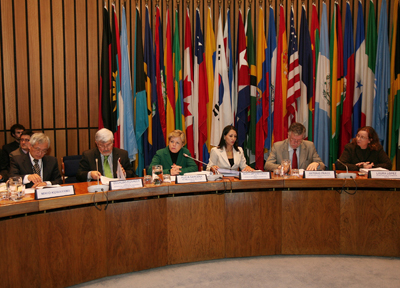Regional Exports Expected to Rise 21.4% in 2010
Topic(s)
According to the study Latin America and the Caribbean in the World Economy 2009-2010, the expansion of trade over the past decade was due more to prices than to value added.

Watch multimedia presentation by ECLAC Executive Secretary, Alicia Bárcena
(2 September 2010) Latin American and Caribbean exports will grow 21.4% this year, jumping from -22.6% in 2009 and driven mainly by South American sales of prime materials, according to estimates of a new ECLAC report released today.
The study Latin America and the Caribbean in the World Economy 2009-2010: A crisis generated in the centre and a recovery driven by the emerging economies states that this boom is largely due to purchases from Asia, particularly China, and the normalization of United States demand.
Regional exports to China rose from -2.2% in the first semester of 2009 to 44.8% during the same period this year.
However, there are significant differences within the region. Growth has been much greater in countries that export natural resources (agricultural, livestock and mining products), namely South American nations, while it has been slower in countries that import basic commodities and depend on tourism and remittances, such as Central American and the Caribbean economies.
The differences per subregion are also significant, according to ECLAC estimates: this year, exports from Mercosur are expected to increase 23.4% and those from Andean nations 29.5%, but sales from the Central American Common Market will expand only 10.8%. Exports from Mexico, for example, will rise 16% and from Panama 10.1%, but sales from Chile are estimated to grow 32.6%.
The most notable upswing from the worst period of the crisis in 2009 is expected in the Caribbean Community (CARICOM), whose exports are estimated to leap from -43.6% that year to 23.7% in 2010.
Balance of a decade
The report also examines trade developments in the region over the past decade, concluding that export growth during those ten years was slower than in the 1990s and lower than in other developing regions, both in value and volume. However, the region took two different routes during that time: South America doubled export growth, while in Mexico and Central America it dropped over 50%.
This disparity is largely due to the fact that the exports that most increased were natural resources from South America, at the expense of manufactured products and services with varying degrees of technological content. According to the report, the subregion has reverted to an export structure based on prime materials similar to that of 20 years ago.
While in 1999 natural resources made up 26.7% of total exports from the region, in 2009 they composed 38.8% of the total.
The difference in the growth rates of natural resource exports and manufactured goods realigned the relative weight of Mexico's exports, on the one hand, and sales from South America, on the other.
The participation of Mexico in the region's total exports fell from 40% in 2000 to 30% in 2009, while Brazil increased its participation from 13% to nearly 20% during the same period. Argentina, Chile, Colombia and Peru also expanded their participation in total exports based on the sale of natural resources.
The region has been unable to improve the quality of its international insertion and the expansion of natural resource-related sectors does not seem to have contributed sufficiently to the creation of new technological capacities, states the report.
"The diversification of exports, a strong boost to competitiveness and innovation and greater regional cooperation will allow Latin America and the Caribbean to improve the quality of its insertion in the global economy, close productivity gaps and capitalize the opportunities of international trade in order to grow with more equality," said ECLAC Executive Secretary Alicia Bárcena during the launching of the report at Commission headquarters in Chile.
See also:
- Table. Latin America and the Caribbean: Average Annual Rates of the Variation of Merchandise Trade, 2008-2009 and Projections for 2010
- Graph. Latin America and the Caribbean: Evolution of the export structure of since the early 1980s
- Fact sheet: Economic cooperation and ties between Japan and Latin America and the Caribbean
- Fact sheet. Trade and integration in the Caribbean: trends and prospects
- Presentation by Alicia Bárcena, ECLAC Executive Secretary (in Spanish)
The report and press releases in electronic format will be available in the ECLAC webpage.
For enquiries, please contact ECLAC's Public Information and Web Services Section. Email: dpisantiag@cepal.org ; telephone: (56-2) 210-2040/2149.
Related content
Cooperación y relaciones económicas entre Japón y América Latina y el Caribe
Presenta información sobre la actual cooperación y relaciones económicas entre Japón yAmérica Latina y el Caribe e identifica posible nuevas oportunidades para el futuro.

Regional Exports Expected to Rise 21.4% in 2010
According to the study Latin America and the Caribbean in the World Economy 2009-2010, the expansion of trade over the past decade was due more to prices than to value added.

Comercio e integración en el Caribe: tendencias y perspectivas
Hoja informativa describiendo las tendencias y perspectivas del Comercio e integración en el Caribe y sus diversas economías.

Estudio económico de América Latina y el Caribe 2009-2010
Presentación de Alicia Bárcena, Secretaria Ejecutiva de la CEPAL. Santiago, Chile, 21 de julio de 2010.
Country(ies)
- China
- South America
Contact
Public Information Unit
- prensa@cepal.org
- (56 2) 2210 2040